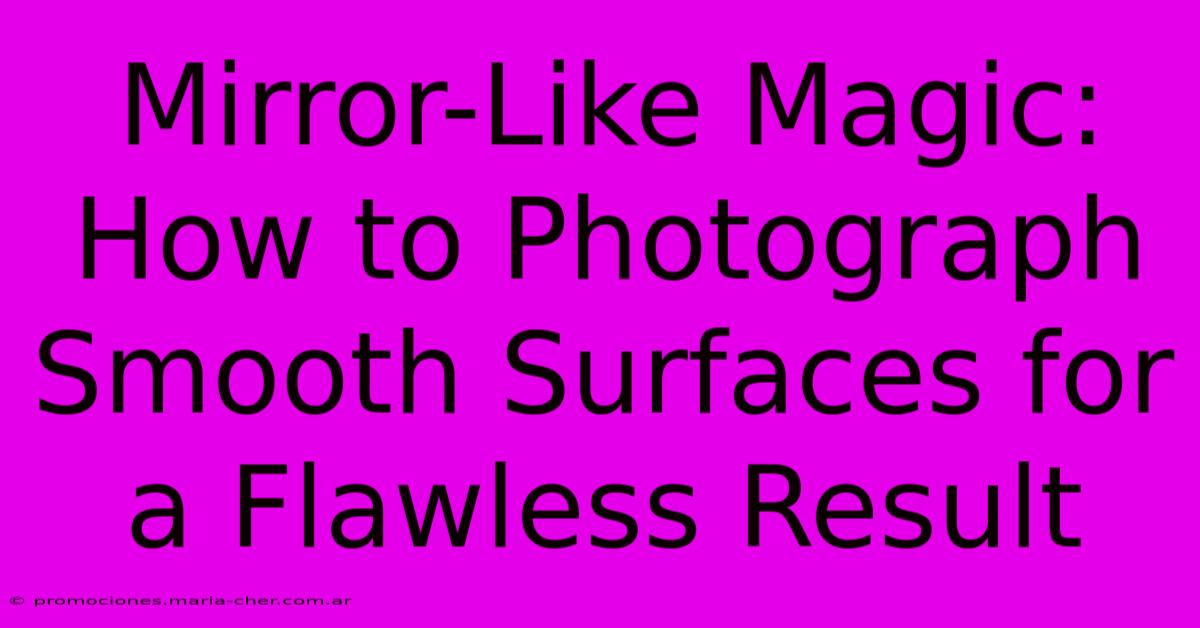Mirror-Like Magic: How To Photograph Smooth Surfaces For A Flawless Result

Table of Contents
Mirror-Like Magic: How to Photograph Smooth Surfaces for a Flawless Result
Photographing smooth, reflective surfaces like glass, metal, or polished wood can be tricky. One wrong move, and your image is plagued with unwanted reflections and distracting glare. But mastering these techniques can unlock stunning visuals, transforming ordinary objects into captivating works of art. This guide will reveal the secrets to achieving flawless results when photographing these challenging subjects.
Understanding the Challenges of Smooth Surfaces
The primary hurdle when photographing smooth surfaces is unwanted reflections. These reflections can obscure the subject itself, or introduce distracting elements from your surroundings – everything from your own reflection to the studio lights. The highly reflective nature of these surfaces means light bounces off unpredictably, leading to uneven exposure and harsh highlights.
Mastering Light Control: The Key to Success
The solution lies in mastering light control. This isn't just about having light, but about managing it with precision.
-
Diffused Light is Your Friend: Harsh, direct sunlight or strong, bare bulbs will create overly bright highlights and dark shadows, completely washing out detail. Instead, opt for soft, diffused light. Think cloudy days for outdoor photography, or using diffusers (like softboxes or umbrellas) with your studio strobes.
-
Light Placement is Crucial: Experiment with the angle of your light source. Positioning the light source low or high can dramatically alter the reflections, allowing you to minimize or even highlight specific areas. Side lighting can often be most effective in minimizing direct reflections from your camera position.
-
Reflectors and Fill Cards: To further control light and shadows, use reflectors to bounce light back onto shadowed areas and fill cards (white or grey foam boards) to subtly reduce highlights. These tools give you fine-grained control over the overall look of your image.
Beyond Lighting: Essential Techniques for Smooth Surface Photography
Beyond lighting, other techniques are critical for capturing sharp, detailed images of smooth surfaces.
Camera Settings and Techniques:
-
Aperture: Choose a narrow aperture (e.g., f/8 or higher) to maximize depth of field and ensure sharpness throughout the image, especially important for intricate details.
-
Shutter Speed: Use a fast enough shutter speed to prevent camera shake and motion blur, especially when shooting handheld.
-
Polarizing Filter: A circular polarizer is a game-changer for smooth surfaces. It helps reduce glare and reflections significantly, revealing more detail and saturation within the object. Experiment with rotating the filter to fine-tune its effect.
-
Focus Points: Pay close attention to your focusing points. Achieving crisp focus on smooth surfaces can be challenging. Using manual focus and a magnifying view might be necessary to ensure pinpoint accuracy.
-
Angle of Approach: The angle at which you approach your subject also affects the reflections. Experiment with different perspectives to find the most flattering angle that minimizes distracting glare.
Post-Processing Refinements
Even with careful planning and execution, some minor adjustments might be needed in post-processing.
Using Software for Enhancements:
Software like Photoshop or Lightroom can be used for subtle enhancements. You can selectively adjust highlights and shadows to further refine your image, or use cloning and healing tools to remove any minor blemishes or distractions not eliminated during shooting. However, remember that subtlety is key. Over-processing can result in an unnatural or artificial look.
Conclusion: Achieving Photographic Perfection
Mastering the art of photographing smooth surfaces requires a blend of technical skill, creative vision, and a keen eye for detail. By understanding the challenges and employing the techniques outlined above, you'll be well-equipped to capture stunning, flawless images that showcase the beauty and reflective qualities of your subject matter. Experiment, practice, and you'll soon be producing mirror-like magic in your own photography.

Thank you for visiting our website wich cover about Mirror-Like Magic: How To Photograph Smooth Surfaces For A Flawless Result. We hope the information provided has been useful to you. Feel free to contact us if you have any questions or need further assistance. See you next time and dont miss to bookmark.
Featured Posts
-
Discover Your Inner Pixie Dust How The Disney Movie Community Inspires Creativity
Feb 07, 2025
-
Elevate Your Reading Experience Mastering The Line Of Text
Feb 07, 2025
-
Shadow And Light Explore The Art Of Black And White Photo Spot Lighting
Feb 07, 2025
-
Investment Vs Indulgence Decoding The Value Proposition Of Vermeil And Gold Plated
Feb 07, 2025
-
The Ultimate Guide To Choosing The Right Sd Card V60 Vs V90 Making An Informed Decision For Your Tech Needs
Feb 07, 2025
